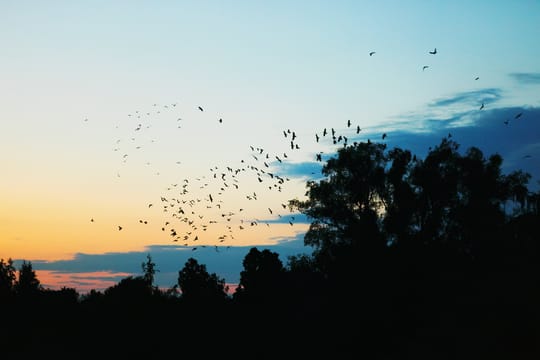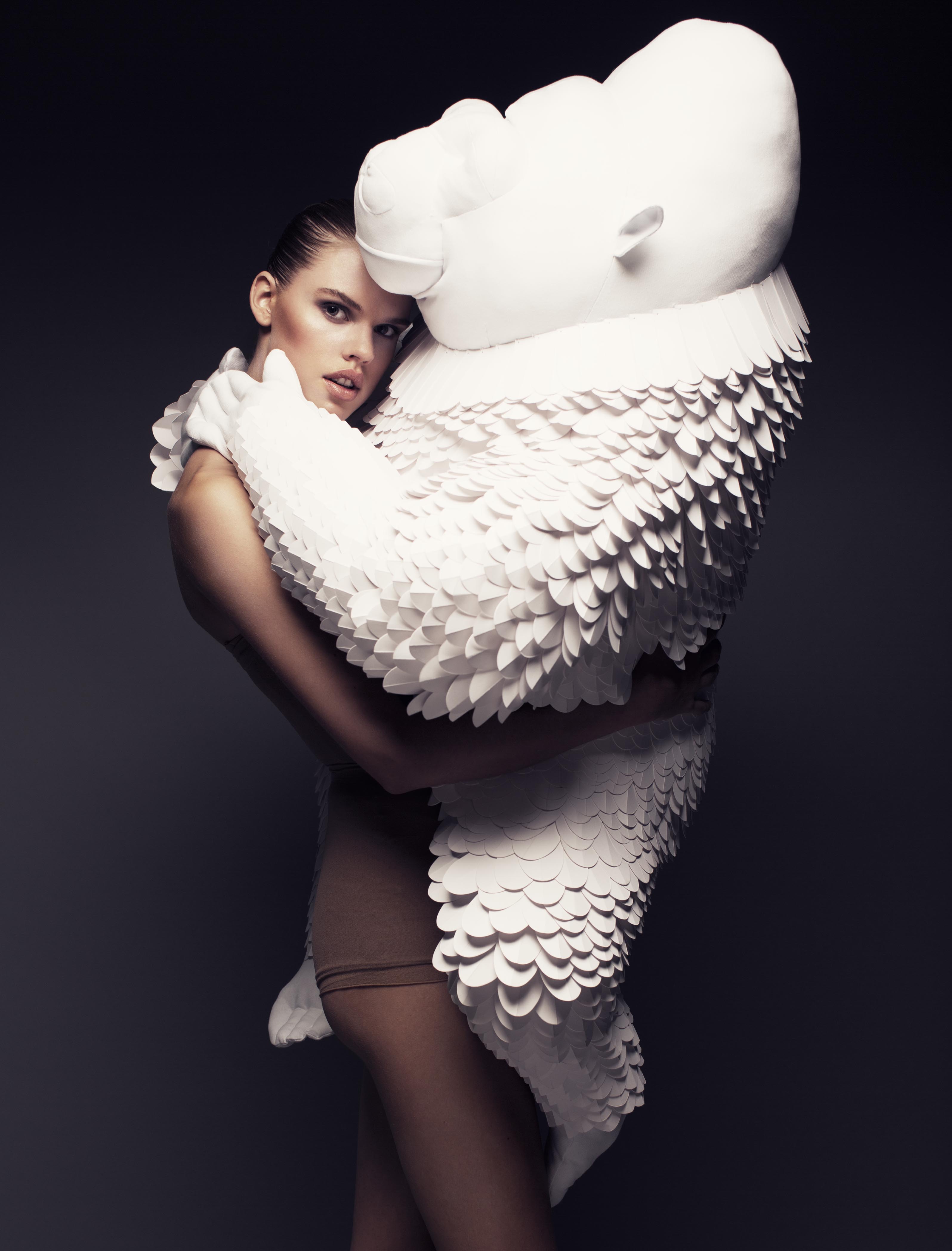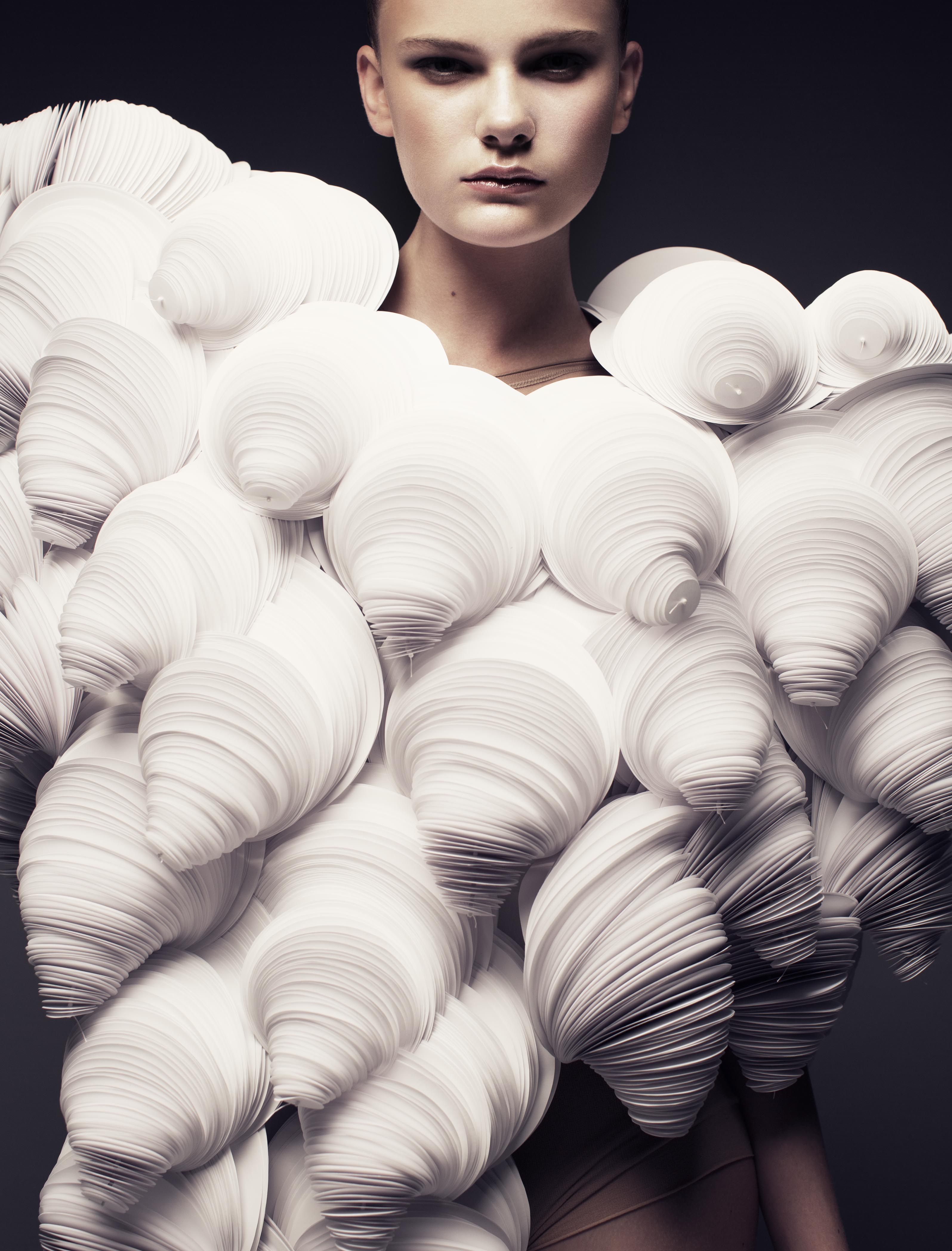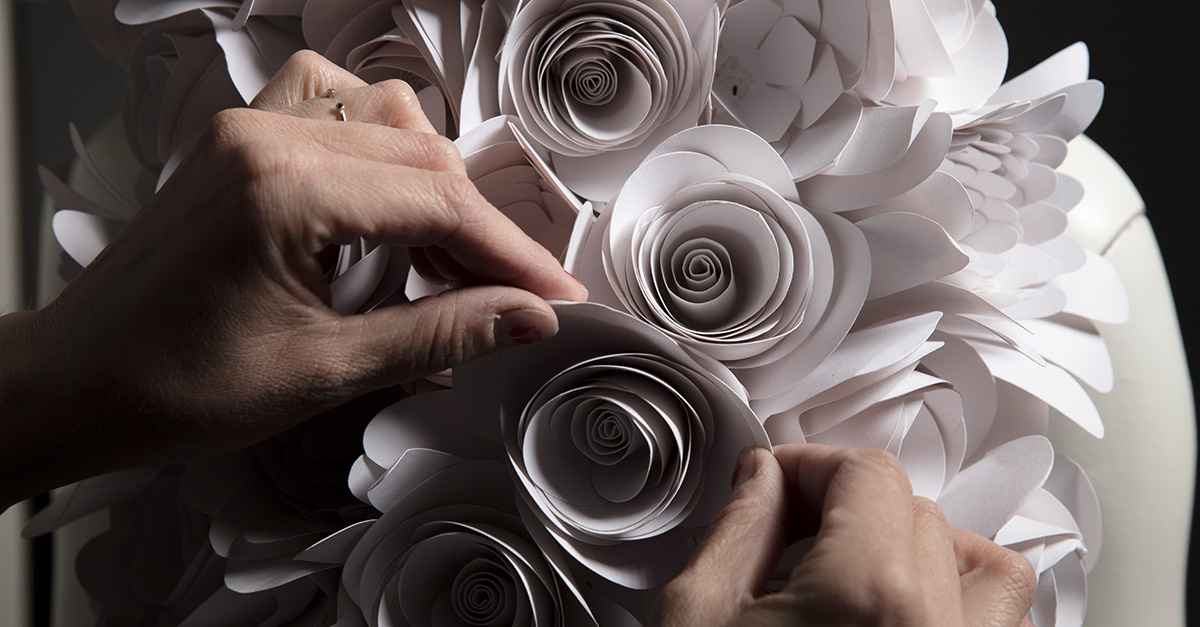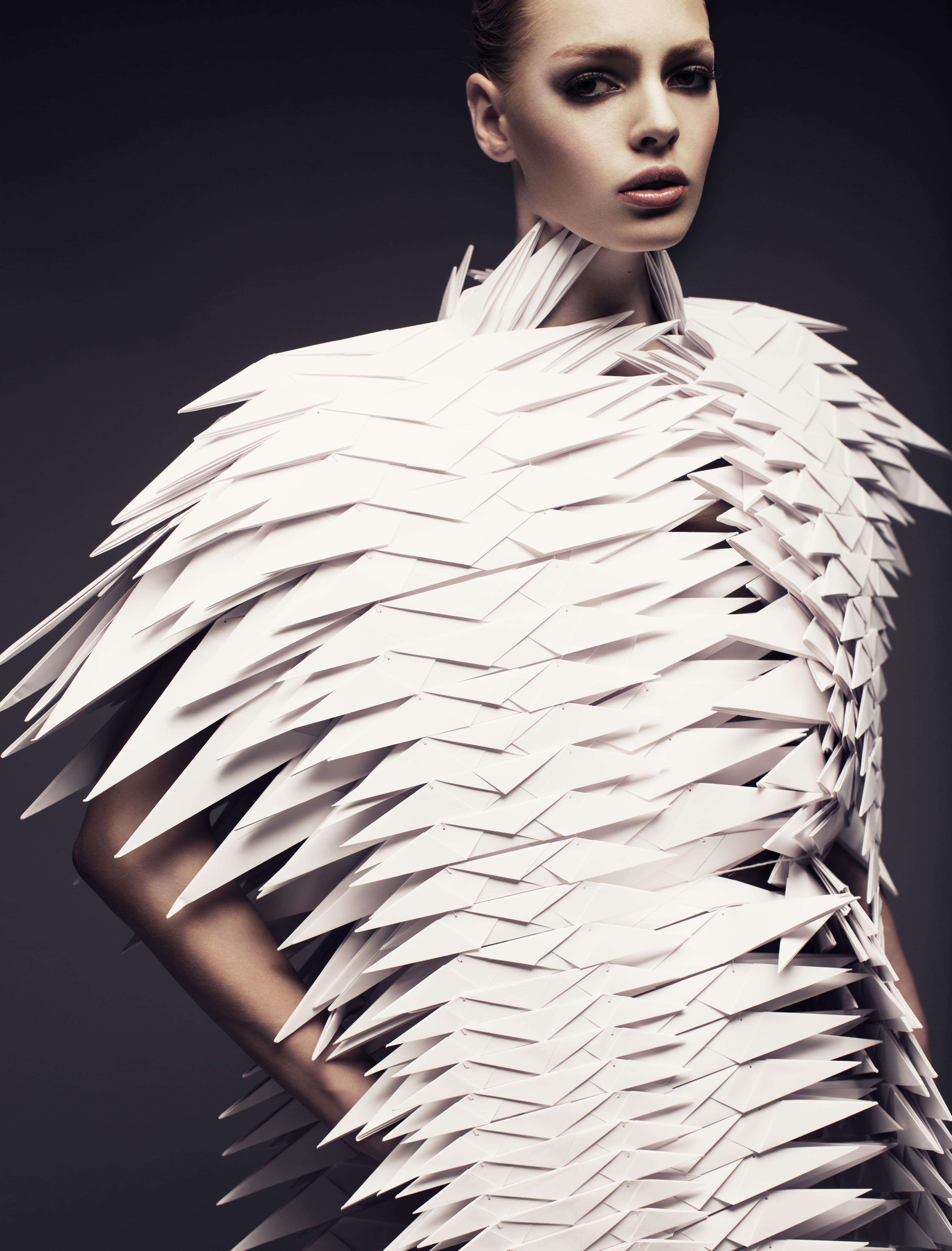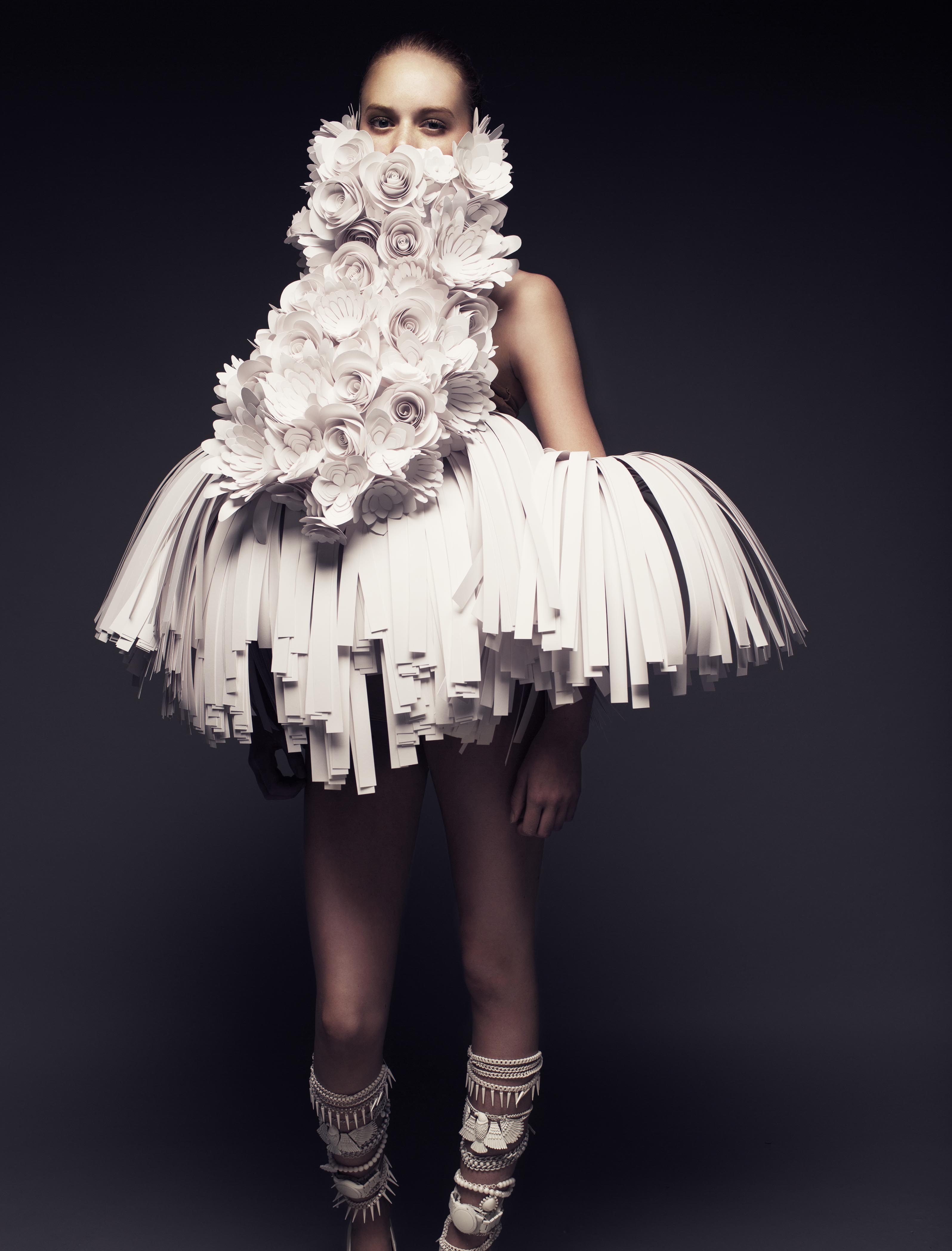
The future is handmade
Art and culture are excellent ways to turn given concepts upside down, and create new approaches and solutions. One avant-gardist, who does not fear new paths, is artist and designer Bea Szenfeld. She is the trained potter who’s giant paper dresses now can be found on celebrities, at the Nobel prize ceremony, in fashion magazines and in museums. We met with her to hear her thoughts on exploring new materials – and how she came to fell in love with paper.
Art, paper, scissors
Bea Szenfeld, has always felt an urge to express herself through different types of mediums and materials. She is a trained potter, cutter and fashion designer and has done her trainee at Stella McCartney’s. But she felt out of place working with fashion, and experienced that she came too far away from what she actually loved.
– After my training and education in fashion and design, I started my own brand of clothes, says Bea Szenfeld. But I noticed after some time that the majority of my time was spent on dealing and trading with textiles, or with marketing – and that was not my forte. I love design, and I love the human body. So I started doing some small projects on the side, where I had a more artistic approach to the human form and figure. That is when I began to do clothes in other material than fabric. And I noticed that when I did a dress out of salad or pasta, the focus shifted from “can I get this in another size?” to “oh, this is design – a new way of dressing the body and contouring silhouettes!”.
During this period, Szenfeld describes, she did many trials and errors with different materials, but quite soon discovered the simplicity with paper.
– I did some tests in paper, and thought “this is too good to be true!”, Bea Szenfeld laughs. It was incredibly simple, and paper is such a beautiful material. It's such an easy job, once you play in its league. Once you have learned paper, it is truly so gratifying!
Heavy light-weight
Even though Szenfeld has found her core material, it is still an explorational journey for her creations. Most often, it is the practical conditions that limits the creative possibilities in her work. Despite the light weight material, Szenfeld’s creation are surprisingly heavy, and sometimes hard to transport. Therefore, the garment is shipped in disassembled pieces – and then reassembled on a model when in use.
– The garments I make can often break in shipping or handling, and many of my pieces weigh over 20 kg, Szenfeld explains. So I have found a way to store and transport these creations in small pieces, where I instead dress on every single garment. I build these sculptures and assemble them one by one. Paper can withstand quite a lot, but not too much. Therefore, you need to trick the eye, and also the paper, a little. If I cut a little cardboard and a little tissue paper in between, I can trick the eye into thinking "this feels fragile", but still it is a support in the form of the solid cardboard.
Szenfeld has, with her experimental creations and unusual concepts, proven that sometimes you don’t need to label what you do. You just need to do. Her pieces really leaves no one unimpressed, and that is the intention. A common denominator in her work is emotions – and humor.
– Yes, humor is very important! Szenfeld laughs. I really try to be serious, but despite that, when I had my fashion show in 2015, people laughed when my models came out. Because "here comes the model carrying a 200-kilo gorilla like a handbag". I believe that fashion needs to be paused a bit, because it gets ridiculous when it gets too cool.
 "I believe my strength has been that I have never been still. I am constantly testing my way forward." Bea Szenfeld, artist & designer
"I believe my strength has been that I have never been still. I am constantly testing my way forward." Bea Szenfeld, artist & designer
Sustainable fashion
As recent times have shown, we need to rethink and challenge given frameworks to find a more durable way forward. Even though the art pieces requires a lot of material, the resources used are environmentally friendly, and most definitely circular.
– I work with plain paper, no special treatments on it or anything, Szenfeld explains. Plain paper, directly from the paper mill here in Sweden. The great thing about paper is that we have been producing and recycling paper for so, so many years. It is one of the oldest materials we reuse, which means that it is not rocket science - we know this, we know how to manage this resource.
All surplus and waste pieces from the art objects can be put straight in the paper recycling. Since no materials are mixed, everything can be pulled apart and recycled or reused. When the lifespan of a garment is finished, the threads are removed and the glass/plastic beads are reused. The paper is just put in the recycling bin. It really is circular art. And for the garments that still lives on, depending on the storage and treatment it can really be long lasting.
– My paper sculptures can be stored and kept for as long as you like, it all depends on how you handle them, Szenfeld explains. They cannot be exhibited in direct sunlight or in a humid room, but if they are handled by me or museum staff, they last for decades.
Different target groups
Apart from exhibiting her art at museums and in fashion magazines, Szenfeld is also a recurrent feature in one of Swedish Televisions most watched TV-magazines, Go’kväll (Good Evening). There she has a standing mission on a reoccurring basis, a DIY-project that is either recycled or upcycled.
– I love those projects, Szenfeld smiles. I have about 7 minutes to show a DIY-craft that people can do themselves at home. In those projects, I find that lamps and luminaires are among the best things to use. You can do simple things and it is always needed at home. And especially now with LED lighting, when the light source does not get hot, the possibilities are so much more and vivid! It really enables you to work with more recycled materials than previously.
Yet another aspect regarding the material is that people from so many different target groups can relate to it. Everyone from pre-schoolers, craftsmen, designers or engineers – they all enjoy the magic and illusions created with regular paper.
– That is truly one of the things I love about my paper clothes, that I can float out without a straight horizon, Bea Szenfeld says. If you like art, you may like my stuff. If you like fashion, you can like my stuff. When I exhibit in cities with paper or forest industry, there are usually visitors who work with paper - who have never seen it used like this. They might work with cardboard and large sheets, and so all of a sudden they see how their material can become something completely different. And those who love crafts, the same thing. You can do so much with paper, scissors, a ruler and some time - it's completely crazy! It's really lovely to find entrances to so many different audiences.
Tabula rasa
So, how does the future looks like for art in general, and more sustainable art in particular? Is there a visible trend for designers and artists to work more circular?
– Yes absolutely! Szenfeld states. I am part of the jury in Ung Svensk Form (Young Swedish Form) and at least half of all projects that contribute are about recycling and reusing. Either they reuse materials or create designs that are easy to reuse.
Not only is sustainability a high awareness among the upcoming artists and designers, so is also the love for crafts and handmade work.
– I love that, but we craftsmen must never relax and think that “this is good, now crafts are in", Szenfeld says with emphasis. We must always fight for recognition, and the time we spend. What we do is not a quick fix, a craft takes time to learn. That's something we need to explain to the new generation, that you have to take time with things. Now we have a world that spins so incredibly fast. From one day as unknown, to another day as world-famous on TikTok. That was not the case before, then you had the chance to grow up a little cautiously. Crafts are really slow techniques, and that is the way it must be.
Fact on Bea Szenfeld:
- She is trained potter and cutter, as well as graduated from Beckmans School of Design.
- After participating in Project Runway, she earned her internship at Stella McCartney.
- Has dressed celebrities such as Lady Gaga, Björk and Loreen.
- Designed the Swedish minister of Culture Alice Bah-Kunkhe’s dress for the Noble Dinner.
- Has explored other materials as well, and made a dress out of pasta for Barilla and clothes entirely of PVC.
TEXT MARIA VÅRENIUS
PHOTO EA CZYZ, JOEL RHODIN
Related News

Cerramos el ciclo: y ampliamos el ciclo de vida de las luminarias
El concepto de reconstrucción de luminarias usadas para ahorrar material y energía está en auge. A veces, lo único que necesita una luminaria obsoleta para brillar de nuevo es un poco de cariño y capacidades de ingeniería. Quedamos con Emma Hallman, Mathilda Holl y Andreas Ekslätt, el equipo de ReLight de Fagerhult, para hablar sobre los desafíos de encontrar soluciones que llevarán las luminarias usadas al futuro. En Fagerhult, una cultura de la innovación profundamente arraigada influye en todos los aspectos del trabajo. Posiblemente, surge de la mentalidad del fundador Bertil Svensson de resolver problemas con medios a veces pequeños, y curiosidad y dedicación. A diferencia de lo que pasa hoy en día, la sostenibilidad puede no haber sido una palabra de moda por aquel entonces. Sin embargo, utilizar nuestros recursos de forma consciente y esforzarse por lograr una alta calidad siempre han sido los pilares de Fagerhult. Hoy en día, un nuevo enfoque sobre la circularidad nos ha instado a cuestionar nuestra forma de pensar y nos hace conscientes de la necesidad de encontrar soluciones duraderas El departamento de soluciones de iluminación a medida (BLS, por sus siglas en inglés) de Fagerhult ha desarrollado luminarias únicas y soluciones adaptadas durante muchos años. Por lo tanto, rehabilitar y actualizar las luminarias usadas es algo que nos resulta familiar. Sin embargo, la ambición de reutilizar y reconstruir luminarias usadas para reducir el impacto climático ha aumentado con el tiempo. En este proceso, el diseño y la tecnología de ayer se ponen al día con los avances de hoy para satisfacer los requisitos del mañana. Cita Haga que sus luminarias usadas se vuelvan a encender Para el equipo de ReLight de Fagerhult, no hay preguntas peculiares ni soluciones imposibles. A diario, gestionan consultas sobre soluciones de iluminación especialmente desarrolladas para proyectos de los mercados de Fagerhult. Es un proceso complejo, pero, con el tiempo, han aprendido que algunos proyectos son ideales para reutilizar luminarias usadas en lugar de invertir en otras nuevas. «Para nosotros, las cualidades de la luminaria en cuanto a comodidad, seguridad y estética de la iluminación son el núcleo de cada proyecto ReLight. También calculamos minuciosamente cuánto podemos reducir el impacto climático total de la luminaria a lo largo de su ciclo de vida, en caso de que se pueda reducir. Si se cumplen todos estos requisitos, comenzaremos a desarrollar y diseñar un nuevo kit», afirma Emma Hallman. En ReLight, existe una voluntad abierta de ahorrar materiales y energía, y hacer un esfuerzo medioambiental actualizando las luminarias. Sin embargo, no todas las luminarias usadas pueden vivir para siempre; algunas están obsoletas y es mejor reciclarlas que reacondicionarlas. Img «Si las circunstancias no cumplen con nuestros requisitos y no funciona para reacondicionar la luminaria, no dejaremos que el proyecto avance más. Nunca pondríamos en peligro la comodidad, calidad, seguridad o la expresión de la luminaria si no resulta en una solución final de primera clase», dice Emma Hallman. En Fagerhult, la seguridad y la calidad son los hilos conductores que unen todos los productos. Y ReLight no es una excepción. A lo largo del proceso, el marcado CE y los ensayos son factores cruciales. «Para garantizar la calidad general, no se deben montar piezas sueltas in situ. Queremos que el montaje sea lo más eficaz y rápido posible, y el nuevo kit encajará perfectamente con los orificios de tornillos antiguos. La unidad está lo más cerca posible de ser una luminaria completa», comenta Andreas Ekslätt.
La nueva tecnología y el control inteligente marcan el camino para el futuro de la iluminación de exterior
Toda la luz eléctrica es producida por (y para) nosotros, el ser humano. Los estudios se centran ahora en algunas cuestiones importantes: ¿iluminamos los entornos exteriores a expensas de otras especies? ¿Y cómo podemos crear un entorno seguro, en equilibrio con el ecosistema y con una contaminación lumínica mínima? La iluminación de exterior prolonga el día y es necesaria para crear seguridad y unos entornos atractivos, incluso cuando ha caído la noche. Sin embargo, cualquier luz que se dirija incorrectamente, se utilice en el momento incorrecto del día o carezca de un propósito puede considerarse contaminación lumínica. Además, es un desperdicio de energía y puede afectar negativamente al bienestar del ser humano y al hábitat de los seres vivos. «Estamos en medio de un rápido desarrollo, donde la biodiversidad se ve amenazada. Esto sucede en gran medida debido a los seres humanos, y la iluminación es un factor que contribuye a ello. Algunos animales se sienten atraídos por la luz y otros la evitan, lo que puede crear un desequilibrio en el ecosistema», afirma Henrik Sandqvist, director de productos y aplicaciones de iluminación de exterior de Fagerhult. Henrik Sandqvist, director de productos y aplicaciones de iluminación de exterior de Fagerhult Sin embargo, en la actualidad existen estándares limitados relativos al lugar y al momento en el que se debe utilizar cada iluminación. Bioinclusive Lighting consiste en una buena luz para el bienestar de las personas y el desarrollo urbano, pero con el menor impacto posible en la biodiversidad. «Como fabricante de luminarias, somos conscientes de que estamos ayudando a aumentar la cantidad de luz. Esa es la razón por la que nosotros también podemos formar parte de la solución. Seguimos las investigaciones y los estándares rectores, y respaldamos a aquellos que saben más que nosotros. Queremos mantenernos a la vanguardia y, a la hora de desarrollar productos, siempre tenemos en mente a Bioinclusive Lighting. Nuestra luminaria Evolume 1 también se ha utilizado en un estudio junto con la Universidad de Gävle y RISE, y estamos encantados de colaborar con otros actores para encontrar las soluciones del futuro». Un entorno de luz más oscuro Hoy en día, alrededor del 80 % de la población mundial no puede ver un cielo estrellado. La razón es el brillo del cielo nocturno: la dispersión de la luz que se refleja en el cielo. El fenómeno es difícil de cuantificar, pero, al igual que otras formas de contaminación lumínica, puede tener efectos negativos en las personas, los animales y el medio ambiente. «Al igual que apagamos las luces cuando salimos de una habitación, también deberíamos asegurarnos de que la iluminación de exterior se apague o atenúe cuando no haya personas cerca. Aquí queda meridianamente claro que la luz adecuada, en el lugar y momento adecuados desempeñan un papel importante». Henrik Sandqvist quote Dado que la iluminación puede afectar a los hábitats de las especies, la iluminación debe tener más en cuenta el ecosistema. Al reemplazar o instalar una iluminación nueva, es importante hacerse la siguiente pregunta: ¿Cuál es el propósito de la iluminación? ¿Cómo afecta al entorno, a las personas, a los animales y a la naturaleza? «La idea de la que partimos es que toda la iluminación debe tener un propósito y la naturaleza e intensidad adecuadas. Debe adaptarse en cantidad y solo debe dirigirse allí donde sea necesario. Dado que la naturaleza de la luz está controlada por su distribución espectral, queremos evitar la luz en las longitudes de onda más bajas. Por ello, la recomendación general es utilizar la luz más cálida posible». Annika Jägerbrand (Universidad de Gävle), Maria Nilsson Tengelin (RISE) y Henrik Sandqvist (Fagerhult). La iluminación adaptativa también puede ajustar la intensidad de la luz y la distribución espectral, y el control del tiempo y la presencia permite una iluminación precisamente cuando es necesaria. «Esto no es nada nuevo y hoy no solucionamos nada. Pero un buen comienzo es acudir a un diseñador de iluminación con un buen conocimiento de iluminación en exteriores que considere el conjunto cuando busque una solución. Seguimos centrándonos en encontrar un enfoque inclusivo cuando creamos luz para las personas en equilibrio con el ecosistema», concluye Henrik Sandqvist. Producto en el punto de mira: Evolume La serie de luminarias Evolume ofrece un buen confort lumínico y ahora está disponible con diversas opciones y temperaturas de color: 2700K, 2200K y PC Amber, así como con luz adaptativa. Esto significa que se pueden adaptar la intensidad, la distribución de la longitud de onda y la distribución en función de la necesidad, el tiempo y la presencia — y una buena oportunidad de tener más en cuenta a los animales y a la naturaleza.